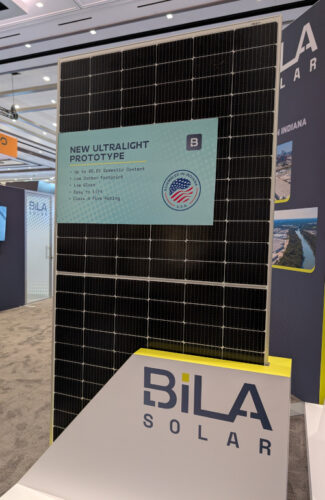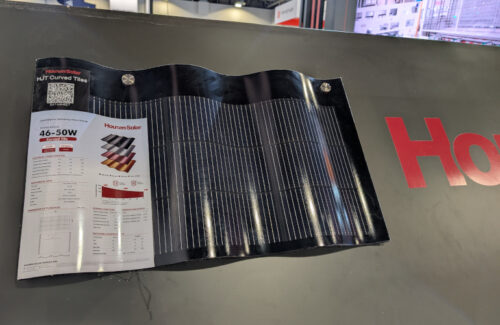
I may be old-school, but I can figure out how to make a gif.
I’m still quite old-school when it comes to reporting on a tradeshow — I carry my small notebook and write down insights in pen. I’m reaching the last page of the notebook I’ve carried since my first Solar Power International with Solar Power World, back 10 years ago. I had a breakfast meeting with LG and then learned about flexible thin-film from MiaSole — both companies are out of business now, but the memories are still there!
The notebook has come in handy as I re-review all the companies that have claimed they’re bringing solar panel manufacturing to the United States. Many haven’t panned out (and many more are added to my “bat**** crazy” header in my private tracking doc), but there are still a few companies standing firm on the promo they have on booth walls. I’m able to read between the lines to determine who is using an OEM and who may actually reach a factory opening, and my confirmed details are in our U.S. solar panel manufacturer list here.
An interesting thing happened at the RE+ 2025 tradeshow last week — fewer companies were advertising “Made in America” solar panels, and instead brands were stating they were “FEOC-compliant.” Of course, the two distinctions are very different, but it feels like the bigger trend happening now. Installing American-made solar panels will be the easiest way to meet new federal entity of concern (FEOC) rules, which prevent projects using too many Chinese components from accessing federal tax credits. But now, solar panels just need to not have Chinese elements to comply, not necessarily be as American as possible.
All of this just means the solar panel manufacturing conversations in this HR1 era are more complicated than before, because buyers have different endgames. So while Solar Power World will continue updating our U.S. manufacturing charts as new developments happen, I’m ready to get back to exploring technology and product advancements in the solar panel space. Gone are the days of solar panel companies advertising a dozen different panel types — from 60-cell to 72-cell options and an all-black panel or one with (gasp) no busbars — and offerings are more standardized in tech. Half-cut cells are the dominant choice, and PERC or TOPCon is the standard. So when something stands out, I’m excited to learn more. I found three stand-outs at RE+ 2025. Let me know what you think!
4-mm glass module from Imperial Star Solar for Erthos
Solar panels built to withstand larger-sized and more intense hail storms are a hot topic in the industry right now, and the consensus among major players Jinko, Trina and Longi is to use tempered glass and go to 3.2-mm thickness where they can. Texas-based solar panel assembler Imperial Star Solar, which fashions itself more as a “custom-order” manufacturer, said why not go even thicker for its customer Erthos. The flat-ground project developer positions panels directly on the earth, which offers no tilt-angles that could protect panels from direct hail hits. A thick, 4-mm top-glass provides the best protection Erthos can find.
But the heavier weight, you say! Yes, the concern with thicker-glass panels is the heavier weight of the final design. But solar panels installed on the ground without racking systems don’t need to worry about weight. The sturdier, stiffer panel from Imperial Star provides another benefit to Erthos — it can better accommodate robotics and other cleaning and maintenance aids that have to glide across the panel surface.
Ultralight panel with 85% domestic content from Bila Solar
 I did say that American-made panels are losing their marketing sparkle, but there is still big demand for high-domestic-content panels in certain markets. Indianapolis-based panel assembler Bila Solar already benefits from its supply of American-made cells from ES Foundry, but it wants to go even further if customers demand more.
I did say that American-made panels are losing their marketing sparkle, but there is still big demand for high-domestic-content panels in certain markets. Indianapolis-based panel assembler Bila Solar already benefits from its supply of American-made cells from ES Foundry, but it wants to go even further if customers demand more.
Bila’s initial plan was to manufacture glass-less silicon panels in Indiana, but market demand led them to start dual-glass, bifacial solar panel assembly this year. The company still believes in its lightweight, frameless design that sandwiches solar cells between polymer sheets, and it is a unique option for commercial rooftops that can’t support a lot of extra weight. And by foregoing glass and frames and using its own polymer blend, Bila can boost the domestic content percentage to over 85%. By using Bila’s solar panels, project developers can stress less on finding American-made mounting systems and other BOS components to meet domestic content requirements.
Curved tiled panels from Hounen Solar
 We’re really still trying unique residential solar panel designs, huh? At least this 50-W curved tile solar panel from Hounen Solar isn’t acting as building-integrated PV (BIPV). This nine-cell HJT setup can come in four different colored “backsheets” — night black, sky gray, brick red and sunny orange. The junction box is on the backside and positioned in one of the curved roof’s peaks.
We’re really still trying unique residential solar panel designs, huh? At least this 50-W curved tile solar panel from Hounen Solar isn’t acting as building-integrated PV (BIPV). This nine-cell HJT setup can come in four different colored “backsheets” — night black, sky gray, brick red and sunny orange. The junction box is on the backside and positioned in one of the curved roof’s peaks.
The panel is only 50 W, but it also only weighs 12 lbs and has no glass. I wasn’t able to learn how the panels are secured to a roof — whether through an adhesive or specialized mount — but it’s another option for the residential market. Solar arrays on curved tiles are one of the trickier installation efforts, so this panel design could be helpful to the market when it comes out of prototype.


